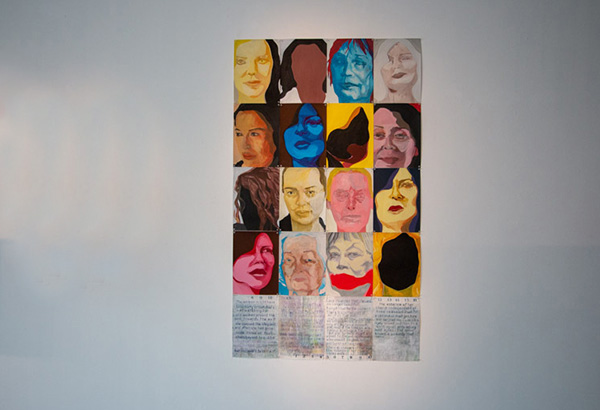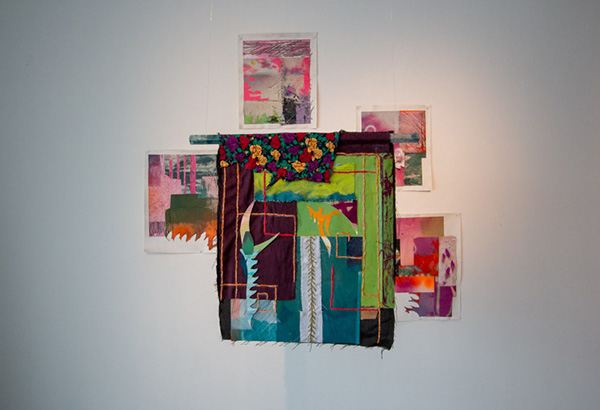Filipino artists: ‘Boro’ an answer to pandemic woes in waste, livelihood, mental health
MANILA, Philippines — The fashion and textile industry is the third most polluting sector globally after food and construction, accounting for up to five percent of greenhouse gas emissions, according to a 2021 report by the World Economic Forum.
Apart from waste and pollution, soaring textile prices due to dwindling supplies in cotton, linen, silk and wool are a major talking point at the ongoing London Fashion Week.
But in the Philippines, artists have found a key to global crises in textile waste and scarcity, while even addressing mental health in the process: by reimagining “Boro.”
“Boro is not literally practiced in the Philippines. It began when Japanese farmers and fishermen had to repair their clothes out of necessity because they lack textile. They would repair and patch these clothes over and over again. That is why (the clothes) look very old. It was just recently that Japan is considering it a work of art, so a lot of Boro has been lost in history,” narrated Stephanie Frondoso.
Frondoso is the curator of “Reimagining Boro,” an ongoing Art Informal exhibit featuring used textile and mixed media with textile. Featuring the works of Winnie Go, Maya Muñoz, Carl Jan Cruz, Brisa Amir and Christina Quisumbing Ramilo, “Reimagining Boro” runs until March 16 in Art Informal Gallery 2, The Alley at Karrivin, Chino Roces Ext. in Makati City.
“The exhibition came to be when artist Winnie Go spent several months in Japan, training in the Japanese countryside, learning the Shibori technique of dyeing. It was a lifestyle of slow living. And instead of just showing the product of that experience, we decided to expand the show into a full show, featuring Filipino artists who use recycling, mending and many other similar characteristics as you would find in Boro,” Frondoso recalled how the exhibit came about.
“My gallery, Art Informal, has been really known not to show one or two-dimensional works. I like to explore and I ask artists to explore different ways of presenting their art aside from what they normally do. And in this case, the idea is a collaboration between Winnie Go, myself and Stephanie Frondoso and we chose artists that would naturally come together and understand the process of Boro… In any way each artist does her art, they do their own interpretation of Boro,” Art Informal owner Tina Fernandez added.
Patchwork nation
Although not literally called "Boro," the same technique of fabric mending is traditionally done by Filipinos through “tagpi-tagpi" (patchwork).
“Translating it to the Philippines, though they don’t literally practice Boro, they do have similar techniques," Frondoso explained.
"As you can see in the artists’ works, they involve patches and mending, and that’s because the Philippines itself, our culture, is an amalgamation of many different elements. In fact, we’ve been described as a ‘patchwork state.’ If you look at our infrastructure, all our roads look like patchwork. The market stalls, the buildings, are all patched together. Different elements, including our hybrid language, our food that combines salty and sour, our folk Catholicism, our mixed cultures – the Philippines itself is patchwork.”
Winnie Go

“I think, anywhere in the world, there’s some kind of ‘Boro,’ to be honest,” enthused Go, who has 16 artworks on display at the exhibit.
From artworks, she has been making Boro scarves and shoals for herself and for family and friends. And now these have also grown in popularity, so she plans to make and sell some pieces for Aphro, an art gallery featuring artists that make one-of-a-kind stuff. The scarves are an amalgam of running Sashiko stitches, dyed indigo, tattered patchwork, holed denim and other fabrics that maybe trash to some, but are treasures for Go.
“The natural aging, wear and tear, is hard to replicate,” she noted. “I think wearable art is amazing.”
She likes making and wearing things that are different “that speaks to your own character.”
“And I think young people today are very sensitive to recycling… They understand their priorities a little more... I think when you go to second-hand shops, vintage shops, a lot of people like to shop in those places. I’m also a fun of that because you’ll find treasures there that you won’t find anywhere because they’ve been made 30 years ago. When nobody makes that anymore and you discovered this thing… it’s precious.”
Similarly, through her works, Go invites everyone to also try doing Boro to reap its benefits.
“If people can find textiles they like, they can start making their own Boro not only using textile but also other found things – mixed media – whatever speaks to them because Boro is about making something that speaks to you, which makes sense for you and more than anything, something that touches your heart and something that comes from your own personal, deep experience.”
Related: ‘Reimagining Boro’: Artist Winnie Go turns ancient Japanese custom into art, fashion statements
Christina Quisumbing Ramilo
An artist for over 40 years, Ramilo has been using different media and stumbled upon Boro for the first time for the exhibit.
“This is challenging because I love Boro and I was excited to work with it,” she told Philstar.com.
At first glance, her first opus, “You Don’t Die in One Day, You Die Slowly,” is an installation that deceptively looks like a hanging cowhide from afar.
Ramilo explained that the piece took inspiration from an Indian concept that when someone dies, you usually burn the remains. In this instance, instead of burning, Ramilo repurposed.
Once upon a time, Ramilo brought home a lovely, thick and massive canvas from New York. It was in storage for over 10 years, but last year, her studio had a termite attack and part of what the pests chomped on was this beautiful and magnificent canvas.
“I wanted to paint and it was difficult for me to see this nice canvas (eaten by termites),” she fretted.
The now ugly-duckling canvas stayed outside her studio for a year. After cleaning it, she recovered only pieces and shreds.
Although she couldn’t use it for painting, it became a tool for something else: mending herself during the pandemic.
Since she stopped working for eight months, it was the first piece she completed in eight months. After sewing almost every day, she finished it closed to a month.
“It was cathartic, almost meditative, to do something slowly and then to see it being whole again.”
Likewise, through the exhibit, Ramilo rediscovered her penchant for drawing. In 2020, after researching and playing with the idea of Boro on paper, she churned out her first drawings in about 10 years: different shades and interpretations of “tagpi-tagpi” rendered using colored pencil, paint and watercolor, among others, in gradations of indigo.
“In 2020, I was drawing every day just to keep sane. It was like my journal. The point was just to do something out of nothing.”
During the pandemic, as an artist, she had “good days and bad days.” She exhibited with a group and also as a solo artist. In fact, a solo show ended on the very day “Reimagining Boro” opened.
“You think of your blessings and it’s difficult. But a lot of people had it worse, right? So you lower your expectations – I get to shower, I get to eat, I have shelter, I don’t get sick. You have friends who love you, you have family. And I always have art. Art has always kept me sane,” she reckoned.
“I’m always happy to see artists post their work because that means they’re working. I don’t know about the art. I think people who love art should support the arts so the cycle goes on.”
The third piece in her series, “Labored Labor,” are her working jeans eaten by termites. She clarified that she merely mended but not embellished it to stay true to her ethos of making something whole again.
“Also part of my work is authenticity, so I don’t like changing things too much because those markings are part of the work.”
After the experience, she is considering to making Boro a permanent medium in her portfolio.
“I’m surprised that I enjoyed stitching. So I might be exploring sewing more in my future works.”
Carl Jan Cruz
Cruz, also known by his nickname CJ, has been practicing the concepts of Boro under his namesake label for over seven years. Active in the fashion industry since 14, Cruz, who is turning 30 years old, studied Menswear from London College of Fashion.
“Uwian,” his collection for the exhibit, was started rolling out production last March 2020 and is a continuous series that keeps on adding new pieces made of patchwork textiles exclusive to his fashion label.
Majority of the fabrics are spare pique fabric and local denim – among the last pieces manufactured by the last-standing denim mill in the Philippines that recently also shutdown, displacing about 300 employees, Cruz claimed.
Inspired by his constant movement from Albay to London, “Uwian” represents Cruz’s search for identity as a young Filipino designer born in Albay but grew up in London and jets between Europe and Manila to showcase his works.
The pieces in the series helped make him and his team sane during the pandemic, thanks to the pieces’ flexibility. From coverings on their workshop’s tables and mannequins, Cruz can imagine the pieces being used as tablecloth or sewn into clothes and into anything the buyer wants from every piece.
According to him, while fashion a decade ago was all about glamour or teaching us “a way to escape,” recycling like using Boro “is our generation’s reaction to designers of the past that paved the way.”
Like the New York designer featured in Vogue that was recently dissed by Filipino onlookers, Cruz admitted that some of his works made of upcycled stuff were called “basahan” (rug). But for him, it’s okay, because it’s the skill that matters more than the material.
He hoped that using recycled materials would no longer be a big deal among Filipino designers. His clients, he shared, have began appreciating clothes made of upcycled stuff because his brand highlights the skillset that goes with the pieces.
“Walang taong ‘di nagbabago and I think it also mirrors the community that we are constantly riding change,” he mused.
More than just material substitution, the use of Boro in fashion and art opens dialogue, according to Cruz.
“It’s not about the idea. It’s about the actual product. I hope more than ever, two years into the pandemic, people are more discerning of quality. You can create (good quality products) with old or new (materials). It doesn’t matter at this point. May mga bagay na rin ngayon na you can buy in such a high premium price pero walang quality,” he pointed out.
“At the end of the day, you should be the one dictating what you create, not the creations dictating you.”
Maya Muñoz and Brisa Amir

Muñoz is a Bicol-based artist who mostly works with paintings. For “Reimagining Boro,” she used recycled paper with paintings on top because “It’s hard to throw away good paper because it’s expensive. But it’s easy to throw away bad works,” Frondoso quoted Muñoz as saying.
Muñoz’s “Immortality” series relates to Boro because “in recycling and recycling, you’re trying to prolong the life of objects.”
Frondoso said Muñoz got her series’ title from a Milan Kundera novel of the same name. As such, the novel's first paragraphs grace her artworks. Like in the book wherein a 60-year-old made a gesture that suddenly made her feel like she’s only 20, Muñoz’s array shows portraits of mature women with sparks of youth.
Using spray paint, house paint, pigments from silk screen and other industrial and construction materials, Muñoz painted her friends as muses.
Amir’s works, on the other hand, discuss people living in informal communities. Last year alone, the artist moved three times, so she makes art in small parts because they’re easier to pack and carry and you can patch them together to make a bigger one.
Frondoso added that Amir liked to incorporate stains – car stains, oil spills, automotive paints and spray paints into fabrics – to illustrate a picture of the city and an informal community.

More than just a showcase of the artists’ latest works, “Reimagining Boro” is testament to Filipino ingenuity and capacity to turn scarcity into opportunity.
“Artists work with what they have, so many of these artists recycled what is already there. For example, fabrics that were eaten by termites were patched together and repaired. Or recycled paper. One of the artists, Maya Muñoz, painted over existing paper because paper is expensive, so she just recycled,” Frondoso vouched.
“So this show shows the ingenuity of Filipinos during times of crises – how we’re able to recycle and still make works of art.” — With reports from Agence France-Presse; Videos by Philstar.com/Efigenio Toledo IV
---
"Reimagining Boro" runs until March 16 in Art Informal Gallery 2, The Alley at Karrivin, Chino Roces Ext. in Makati City.



















